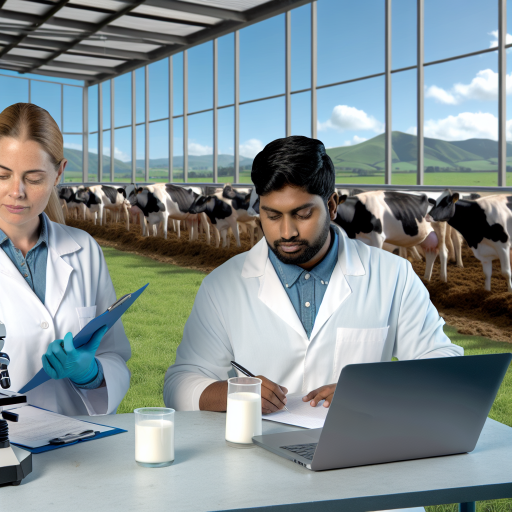Sustainable Farm Business Model
A sustainable farm business model focuses on utilizing environmentally friendly practices while maintaining profitability.
Importance of Creating a Sustainable Farm Business Model
Creating a sustainable farm business model is crucial for long-term success and resilience in the agriculture industry.
Market Analysis and Demand for Sustainable Products
Research current market trends and consumer preferences for sustainable products.
Identify niche markets within the sustainable agriculture sector to target for increased sales.
Conduct surveys or focus groups to gather feedback on potential product offerings.
Stay informed about regulatory changes and certifications related to sustainable farming practices.
Environmental Impact and Conservation Practices
Implement sustainable farming techniques to minimize environmental impact.
Use organic and natural fertilizers and pesticides to protect soil and water quality.
Practice crop rotation and cover cropping to improve soil health and biodiversity.
Invest in renewable energy sources such as solar panels or wind turbines to reduce carbon footprint.
Financial Viability and Profitability
Develop a comprehensive business plan that outlines revenue streams and projected expenses.
Track key performance indicators such as cost per unit and return on investment.
Explore opportunities for grants or subsidies that support sustainable farming practices.
Diversify income streams through value-added products or agritourism activities.
Community Engagement and Social Responsibility
Build relationships with local community members and organizations to support your farm business.
Participate in events or farmers markets to promote your products and connect with customers.
Volunteer or donate to local charities or food banks to give back to the community.
Educate consumers about the benefits of sustainable farming practices and the importance of supporting local agriculture.
By incorporating these factors into your farm business model, you can create a sustainable and successful operation that not only benefits the environment and community but also generates a profit for years to come.
Conduct a SWOT analysis
Before creating a sustainable farm business model, it’s essential to conduct a SWOT analysis to identify strengths, weaknesses, opportunities, and threats.
Transform Your Career Today
Unlock a personalized career strategy that drives real results. Get tailored advice and a roadmap designed just for you.
Start NowStrengths
- Identify what sets your farm apart from others
- Consider factors like land quality, location, and resources
Weaknesses
- Pinpoint areas that need improvement
- Look into skills, infrastructure, or market access
Opportunities
- Explore avenues for growth and expansion
- Consider new markets, partnerships, or product lines
Threats
- Identify potential risks to your farm business
- Consider factors like competition, regulations, or environmental challenges
Set goals and objectives for sustainability
Once you’ve analyzed your farm’s internal and external environment, it’s time to set clear goals and objectives for sustainability.
Long-term Goals
- Define where you want your farm to be in the future
- Consider aspects like profitability, environmental impact, and community engagement
Short-term Objectives
- Break down long-term goals into actionable steps
- Set targets for reducing waste, improving efficiency, or increasing revenue
Implement sustainable practices and technologies
With your goals in place, it’s time to implement sustainable practices and technologies that align with your farm business model.
Environmental Sustainability
- Adopt organic farming methods to reduce chemical inputs
- Implement water conservation techniques like drip irrigation
Social Responsibility
- Engage with the local community through farm-to-table initiatives
- Provide fair wages and support local employment
Economic Viability
- Explore alternative revenue streams like agritourism or value-added products
- Invest in renewable energy sources to reduce operating costs
Monitor and evaluate the progress of the business model
Regular monitoring and evaluation are crucial to ensure that your sustainable farm business model is on track and continuously improving.
Data Collection
- Collect relevant data on key performance indicators
- Track metrics like yield, energy consumption, and financial performance
Analysis
- Review data to identify trends, successes, and areas for improvement
- Use tools like SWOT analysis or sustainability assessments
Adaptation
- Adjust your farm business model based on evaluation findings
- Continuously iterate and innovate to achieve sustainability goals
Learn More: Agricultural Labor Jobs for Veterans: Opportunities and Support
Benefits of a Sustainable Farm Business Model
Creating a sustainable farm business model comes with several advantages.
Here are some of the key benefits:
Long-term Environmental Impact and Conservation
Implementing sustainable practices on a farm can lead to a positive long-term impact on the environment.
By using organic farming methods, reducing chemical inputs, and promoting biodiversity, farmers can help conserve natural resources, protect water quality, and preserve ecosystems.
This not only benefits the farm itself but also contributes to the overall health of the planet.
Improved Profitability and Market Competitiveness
Sustainable farming practices can also improve the financial viability of a farm business.
By reducing input costs, increasing efficiency, and tapping into niche markets for organic or sustainably produced products, farmers can boost their profitability.
In addition, consumers are increasingly willing to pay a premium for products that are produced in an environmentally friendly and ethical manner, giving sustainable farms a competitive edge in the market.
Stronger Relationships with Customers and Community
Sustainable farms often foster strong connections with their customers and local community.
By being transparent about their practices, engaging in direct marketing, and offering educational opportunities such as farm tours or workshops, farmers can build trust and loyalty among consumers.
This not only increases sales but also helps create a sense of community and support for the farm.
Resilience Against External Factors Such as Climate Change
Climate change and other external factors can pose significant risks to farm businesses.
By adopting sustainable practices that promote soil health, water conservation, and biodiversity, farmers can increase their resilience to these challenges.
Healthy soils are better able to withstand extreme weather events, diverse cropping systems are less vulnerable to pests and diseases, and water-efficient practices help farms cope with droughts or water scarcity.
Overall, a sustainable farm business model can help farmers adapt to a changing environment and secure their long-term success.
Showcase Your Business Today
Reach thousands of readers actively exploring professional services. Publish your business profile and grow your audience now.
Publish NowGain More Insights: Innovative Irrigation Techniques for Specialists
Challenges and Potential Pitfalls to Avoid
As you embark on creating a sustainable farm business model, it’s crucial to be aware of the challenges and potential pitfalls that may come your way.
By identifying these obstacles early on, you can better prepare yourself to overcome them.
Here are some common challenges and pitfalls to avoid:
Initial Costs of Implementing Sustainable Practices
One of the biggest challenges when transitioning to sustainable farming practices is the initial cost involved.
Investing in eco-friendly technologies, organic seeds, and sustainable infrastructure can be expensive upfront.
To overcome this challenge, it’s essential to create a detailed budget and plan for long-term returns on your investment.
Resistance from Traditional Farming Methods or Stakeholders
Resistance from traditional farmers or stakeholders who are not yet convinced of the benefits of sustainable farming practices can pose a significant hurdle.
It’s essential to educate your community about the advantages of sustainability and address any concerns they may have.
Building strong relationships with stakeholders can help overcome this resistance.
Balancing Sustainability with Profitability
Another challenge is finding the right balance between sustainability and profitability.
While sustainable practices are beneficial for the environment, they may not always be the most cost-effective option.
It’s crucial to conduct thorough financial analysis and explore revenue streams that align with your sustainable values.
By optimizing your operations, you can achieve a balance between sustainability and profitability.
Lack of Knowledge or Resources for Sustainable Farming
Implementing sustainable farming practices requires specialized knowledge and resources that may not be readily available.
It’s essential to invest in continuous education, attend workshops, and network with other sustainable farmers to stay informed about the latest techniques and technologies.
Collaborating with experts in the field can help you overcome any knowledge or resource gaps.
By being aware of these challenges and potential pitfalls, you can proactively address them and build a successful and sustainable farm business model.
Embrace innovation, stay committed to your sustainability goals, and continuously seek opportunities for growth and improvement.
See Related Content: Understanding Irrigation Scheduling and Management

Case studies of successful sustainable farm business models
Highlight examples of farms that have successfully implemented sustainable practices
In the realm of sustainable farming, there are numerous success stories that serve as inspiration for aspiring farmers.
One such example is Polyface Farm in Virginia, known for its holistic approach to agriculture.
Polyface Farm utilizes rotational grazing, composting, and natural pest control methods to maintain the health of their soil and produce high-quality, nutrient-dense food.
Discuss the strategies and approaches used by these farms
These successful farms prioritize soil health and biodiversity, recognizing the interconnectedness of all living organisms on the farm.
By mimicking natural ecosystems and utilizing regenerative farming practices, these farms minimize the use of synthetic inputs and maximize the natural resources available to them.
This not only benefits the environment but also improves the overall health and productivity of the farm.
Showcase the benefits and impact of these sustainable farm business models
The adoption of sustainable practices has had a profound impact on the profitability and resilience of these farms.
By reducing their reliance on expensive inputs and chemical pesticides, these farms can lower their operating costs and increase their profit margins.
Additionally, by building healthy soil and promoting biodiversity, these farms are better equipped to withstand environmental challenges such as droughts and floods.
Overall, these sustainable farm business models showcase a more holistic and regenerative approach to agriculture that benefits both the farmers and the environment.
Learn More: Success Stories from Extension Agent Initiatives
Creating a Sustainable Farm Business Model
Creating a sustainable farm business model is crucial for long-term success.
Farmers should prioritize sustainability in their business practices to ensure environmental and economic viability.
Farmers interested in implementing sustainable practices should seek available resources.
Government programs can provide guidance for sustainable agriculture.
Community support networks also offer valuable resources.
Additionally, online forums can be a source of advice and shared experiences.
Additional Resources
Funding Opportunities | National Institute of Food and Agriculture
Small and Mid-Sized Farmer Resources | USDA
[E-Books for Sale]
The Big Book of 500 High-Paying Jobs in America: Unlock Your Earning Potential
$19.99 • 500 High-Paying Jobs • 330 pages
Explore 500 high-paying jobs in America and learn how to boost your career, earn more, and achieve success!
See All 500 High-Paying Jobs of this E-Book
1001 Professions Without a Degree: High-Paying American Jobs You Can Start Now
$19.99 • 1001 Professions Without a Degree • 174 pages
Discover 1001 high-paying jobs without a degree! Unlock career tips, skills, and success strategies for just $19.99!




